
Deepak Dhingra
Postdoctoral Fellow, Department of Physics, University of Idaho
Deepak Dhingra is a postdoctoral fellow in the department of Physics at University of Idaho. He works with light reflected in the visible and infrared wavelengths to decipher compositional, textural and morphological properties of planetary surfaces. Deepak is currently studying the water ice plumes on Enceladus, Saturn’s fifth largest satellite.
Deepak has extensive experience studying Earth’s Moon. He has worked with variety of remote sensing data to characterize the mineralogy of impact melt deposits and their corresponding geologic context on the lunar surface. He has also contributed to the study of bright albedo deposits (swirls), high titanium basalts and a new rock-type (Mg-spinel Anorthosite) on the Moon. His discovery of Mg-spinel at Theophilus crater is now regarded as a type area (best area for study) for this new rock.
He holds B.S. and M.S. degrees in Geology from India and M.S. and Ph.D. degrees from Brown University (USA) in the same discipline. Before coming to Brown, Deepak was working as a scientist at the Physical Research Laboratory, a unit of the Department of Space in India. He was involved in the scientific preparations for the Chandrayaan-1 mission—India’s first mission to the Moon.
Deepak has interest in science writing (articles, poems, and conference reports), photography and sustainable development practices.
Latest Articles
The Division of Planetary Science (DPS) Meeting saw many exciting scientific discussions spanning the range of processes on different planetary bodies, as well as their replication in the laboratory and in models.
Deepak Dhingra reports on a planetary analog field trip exploring a very young volcanic terrain in Idaho at Craters of the Moon National Monument and Preserve.
Deepak Dhingra shares some of the latest research on Enceladus' geysers presented at the American Geophysical Union (AGU) Fall Meeting in San Francisco last month.


 Explore Worlds
Explore Worlds Find Life
Find Life Defend Earth
Defend Earth




